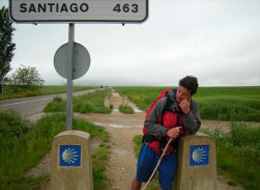About the Camino de Santiago
 Officially, the Camino is any passage in Europe that leads to the city of Santiago de Compostela – essentially it starts at your doorstep! However, what most people refer to as the Camino de Santiago is just one of these routes called the Camino Francés – the 500-mile path that starts just over the border of Spain in St. Jean Pied de Port, France. From there, the Camino winds through 4 of Spain’s 15 different regions.
Officially, the Camino is any passage in Europe that leads to the city of Santiago de Compostela – essentially it starts at your doorstep! However, what most people refer to as the Camino de Santiago is just one of these routes called the Camino Francés – the 500-mile path that starts just over the border of Spain in St. Jean Pied de Port, France. From there, the Camino winds through 4 of Spain’s 15 different regions.
First, travelers make the grueling trek up and over the Pyrenees Mountains, and descend into Navarra – a vibrant, green expanse of mountainous highlands and home to the famous Running of the Bulls in Pamplona. Next, they pass through La Rioja – full of rich vineyards that produce the wine for which this small region is famous. The bulk of the Camino passes through Castilla y León – in which lies a terrain that many find to be the most challenging – the Meseta. This flat, seemingly endless landscape of green and wheat colored crops is said to remove all external distraction, leaving a pilgrim with only their thoughts for company.
In contrast, Castilla y Leon also boasts the beautiful mountain pass where the renowned Cruz de Ferro is located – a huge iron cross under which pilgrims leave a rock imbued with whatever they wish to let go of. The last region, Galicia is a glorious sight to behold, and its rolling hills and lush eucalyptus forests provide a wonderful welcome into Santiago de Compostela.
All along the Camino de Santiago, there are special pilgrim hostels, called “albergues,” which are run by volunteer “hospitaleros” – seasoned pilgrims whose love for the Camino inspired them to return and devote spans of their life to it and its pilgrims. Albergues can be found nearly every five miles, so one may walk as much or as little as desired in a day, although there are instances when the next sign of civilization is more than 10 miles away.
A rare few do the Camino in as little as 20 days, trekking close to 25 miles a day. The majority of pilgrims take between 4 and 6 weeks to walk the entire 500-mile journey. Though it is traditional to walk the Camino on foot, some elect to do it by bicycle or horse. Whatever one’s method of transportation, whichever Camino one chooses to do, and however fast one’s pace is, each of the millions who have stepped foot on the Camino feel its inexplicable magic and are forever changed by it.
History & Legends
The Camino de Santiago is named for Santo Iago, or Saint James – one of the 12 Apostles and rumored brother of Jesus Christ. According to legend, his body was found in a boat that washed ashore in Northern Spain thousands of years ago. His remains were transported inland and were buried under what is now the grand Cathedral of Santiago de Compostela, which marks the end of the Camino. His bones were rediscovered in the 9th century, when a hermit saw a field of stars that led him to the ancient, forgotten tomb.
In the millennium following its re-discovery, millions from all over Europe have walked thousands of miles to visit the remains of the disciple. At the height of its popularity in the 11th and 12th centuries, anywhere from 250,000 – 1,000,000 people a year are said to have made the pilgrimage.
According to Catholic tradition, if you faithfully completed the arduous trek, one’s sins were forgiven. If one completed the pilgrimage during a Holy Year – the infrequent occasion when St. James Day, July 25th, falls on a Sunday – a plenary indulgence was granted, allowing one to bypass purgatory and enter straight into heaven. In the Middle Ages, wealthy aristocrats would often hire people to walk in their name in order to, by proxy, absolve them of their sins without actually setting foot on the Camino.
Historically, many countries have provided criminals with the choice to either serve prison time, or do the Camino. Even today, Belgium will sometimes allow minor crimes to be pardoned by completing the pilgrimage. While, in these cases, the Camino was used as a form of punishment, its impact upon a pilgrim’s connection with themselves and their world community could instead be regarded as an unconventional form of rehabilitation.
UNESCO has declared it a Universal Patrimony of Humanity and a World Heritage Site. In 1987, the European Union declared the Camino de Santiago to be the first European Cultural Itinerary. Although originally known as a Christian pilgrimage, the Camino now attracts people of all faiths and backgrounds – from atheists to Buddhists, adventurers to mourners, and college students to retired friends.
